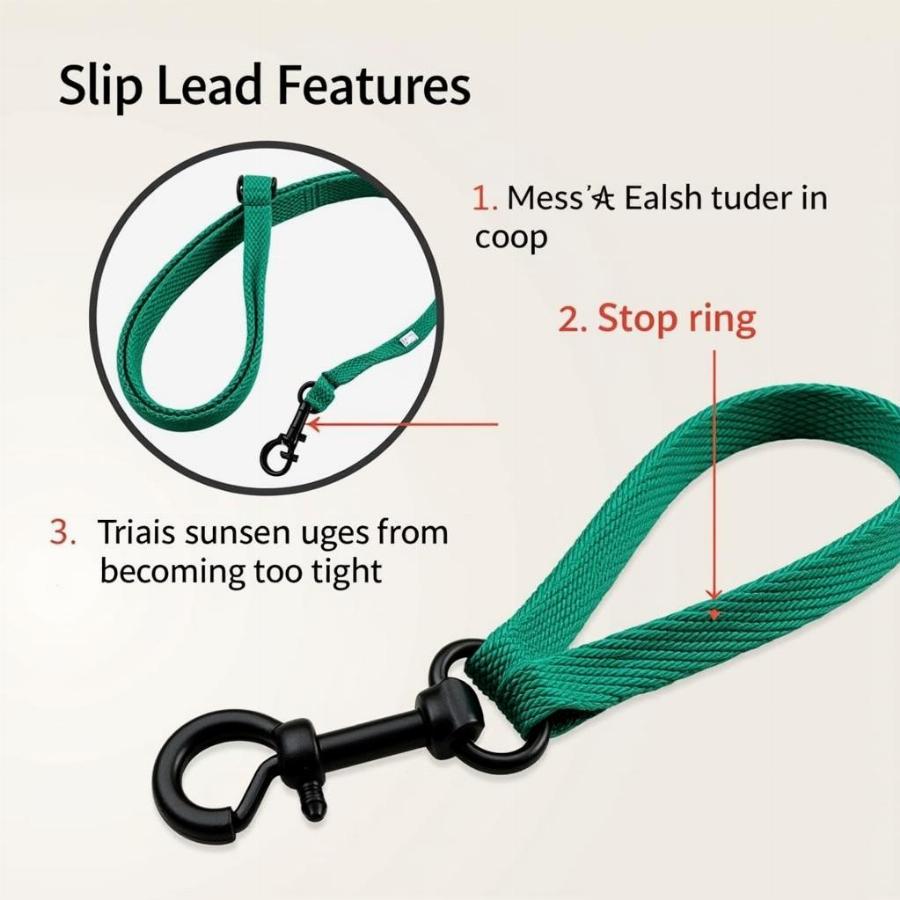A slip lead dog leash, also known as a slip leash or show lead, is a popular choice among dog owners for its versatility and practicality. But what exactly is a slip lead, and how can you use it effectively with your furry friend? This comprehensive guide will delve into the world of slip leads, covering everything from their uses and benefits to choosing the right one and mastering essential handling techniques.
What is a Slip Lead Dog Leash?
 Close-up of a red slip lead dog leash
Close-up of a red slip lead dog leash
A slip lead is a type of dog leash that consists of a single loop of rope or nylon webbing. This loop slides through a metal ring, creating an adjustable collar and leash combination. When used correctly, a slip lead provides gentle control over your dog by applying pressure around their neck when they pull.
Benefits of Using a Slip Lead
Slip leads offer several advantages over traditional buckle collars and leashes, making them a favorite among dog trainers and experienced owners:
- Control: The slip design allows for quick and effective corrections, encouraging your dog to walk politely on a loose leash.
- Versatility: A single slip lead can be used for training, walking, and even temporary restraint due to its adjustable nature.
- Easy to Use: Unlike buckle collars, slip leads don’t require precise fitting and can be quickly put on and taken off.
- Compact: Their simple design makes them lightweight and easy to carry in your pocket or attach to your belt loop.
Choosing the Right Slip Lead for Your Dog
Selecting the appropriate slip lead is crucial for your dog’s comfort and safety:
- Material: Opt for soft, durable materials like nylon or leather that won’t irritate your dog’s skin.
- Thickness: Choose a width that’s comfortable for your dog’s neck size and strength, avoiding anything too thin or too thick.
- Length: Consider your height and the desired walking distance when determining the appropriate leash length.
- Stop Ring: Ensure the slip lead has a stop ring to prevent the loop from becoming too tight and potentially choking your dog.
How to Use a Slip Lead Safely and Effectively
While slip leads can be valuable training tools, they require proper handling to ensure your dog’s well-being:
- Fit: The loop should sit high on your dog’s neck, right behind the ears, for optimal control and to avoid choking.
- Pressure: Apply gentle, consistent pressure when needed, releasing immediately when your dog yields to the lead.
- Training: Use positive reinforcement techniques alongside the slip lead, rewarding your dog for walking politely and following commands.
- Supervision: Never leave your dog unattended while wearing a slip lead, as it could get caught and pose a strangulation risk.
Slip Leads vs. Other Types of Leashes
While slip leads are versatile, they might not be suitable for every dog or situation:
- Puppies and Small Breeds: Opt for a traditional collar and leash or a harness for puppies and small breeds with delicate tracheas.
- Strong Pullers: Consider a no-pull harness or seek guidance from a certified dog trainer if your dog pulls excessively.
- Reactive Dogs: Use a secure harness and a fixed-length leash for reactive dogs to prevent accidental escapes and potential injury.
Mastering the Slip Lead: Tips for Success
- Start Slowly: Introduce the slip lead gradually during short training sessions, gradually increasing the duration as your dog adjusts.
- Be Consistent: Use the slip lead consistently during walks and training to reinforce desired behaviors and establish clear communication.
- Seek Professional Guidance: Consult a certified dog trainer or behaviorist for personalized advice and training techniques tailored to your dog’s specific needs.
Conclusion
A slip lead dog leash can be an effective tool for training and managing your canine companion when used responsibly. By understanding its benefits, choosing the right size and material, and using it correctly, you can enhance your dog’s leash manners and strengthen your bond. Remember, patience, consistency, and positive reinforcement are key to successful slip lead training.
FAQs
Can I leave a slip lead on my dog all the time?
No, a slip lead should never be left on your dog unattended. It can get caught on objects, posing a serious strangulation risk.
Is a slip lead suitable for my puppy?
It’s best to avoid using a slip lead on puppies and small breeds with delicate tracheas. Opt for a traditional collar and leash or a harness instead.
What if my dog pulls excessively on a slip lead?
Consider a no-pull harness or consult a certified dog trainer for guidance on managing your dog’s pulling behavior.
Looking for More Helpful Tips?
Check out these related articles:
Beaut Dogs is your trusted source for all things dog-related. For personalized advice and expert insights, don’t hesitate to reach out to our team at [email protected]. We’re here to support you on your journey as a responsible and loving dog owner.